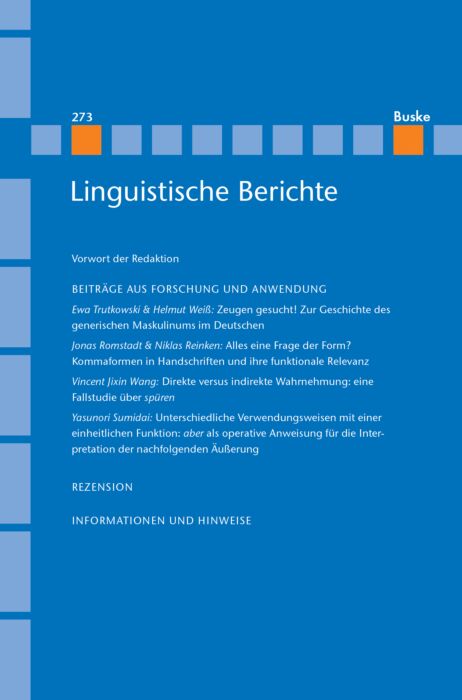Linguistische Berichte Heft 273

Beschreibung
Bibliographische Angaben
| Einband | |
|---|---|
| DOI | |
| Auflage | 1. Auflage |
| ISBN | |
| Sprache | |
| Originaltitel | |
| Umfang | 153 Seiten |
| Erscheinungsjahr (Copyright) | 2023 |
| Reihe | Linguistische Berichte |
| Herausgeber/in | Markus Steinbach Nina-Kristin Meister Günther Grewendorf Arnim von Stechow |
| Beiträge von | Andreas Blümel Klaus Müllner Niklas Reinken Jonas Romstadt Markus Steinbach Yasunori Sumidai Markus Tönjes Ewa Trutkowski Vincent Jixin Wang Helmut Weiß Thomas Weskott |
| Hersteller nach GPSR |
Helmut Buske Verlag GmbH |
Service
Einzelartikel als PDF
On the basis of synchronic and diachronic data, we argue that in the human domain German masculine nouns commonly display a “non-male” generic interpretation which we take as evidence for a separation of syntactic and semantic gender: synchronically, we show that agreement differences between masculine and feminine nouns cannot be traced back to their semantic gender since nouns without sex specification (as e.g. feminine Person (person) or masculine Mensch (human being)) behave just as differently as nouns with sex specification. In the diachronic part, we prove that the so-called generic masculine is a stable and well-documented phenomenon in the grammatical system of German at least since the Old High German period. To substantiate this claim, we present numerous historical examples for the generic use of masculine nouns such as Gast (guest), Nachbar (neighbour), and Sünder (sinner). These nouns allow us to look at the particular language use without confounding it with the sociological problem of women’s lack of professional integration in the past.
19,90 €
There are strict formal requirements for the use of a comma. However, there are none regarding the comma’s actual shape. In printed fonts, it is determined by the font’s specification. In handwritten texts though, the shape of the comma is variable; most writers choose from a set of straight, convex and concave shapes. By using a corpus of 1464 commas written by 99 individuals, we will present three case studies of persons whose comma shapes do somehow correlate with linguistic structures. With that, we might identify a few (possibly subconscious) shaping strategies. Some writers might mark a norm insecurity by a different comma form, others might mark the function of the entity which is segmented by the comma, or the comma type itself (sentence boundary, exposition or coordination).
19,90 €
The German perception verb spüren („feel“), patterning with other perception verbs such as sehen („see“) or hören („hear“), exhibits various kinds of complement type to be selected. In this paper, I exploit a type-based compositional semantics in Asher (2011) to account for these cases. I propose a unified lexicon entry for spüren, which captures three essential semantic properties: First, the direct target of spüren are either special tropes (Moltmann, 2007, 2013) which are considered as concrete manifestations of a particular property associated with sensorial stimuli (r-TRO, e. g., bitterness, warmness), or events which can trigger tactile stimuli (t-EVT, e. g., earthquake, vibration). Second, the process of spüren always depends on the epistemic state of the subject of perception. Third, spüren involves an evidence-relation indicating that its target property should be an accessible evidence for the experiencer’s identifying it or inferring something through it. In case of spüren, two kinds of perception should be distinguished: The direct perception based on sensorially triggered evidence, and the indirect perception representing an inference-based and cognitive process. Formally, the former is reflected in the regular composition, while in the latter case coercion is interpolated.
19,90 €
The conjunction aber (≃ but) is said to have meanings such as semantic opposition, denial of expectation, or opposite evaluations. These meanings are sometimes subsumed under one central meaning like ‘contrast’ or ‘concession’. In this paper, some uses of aber will be examined mostly on the basis of the five types of aber and their examples introduced in Breindl (2004), leading to the conclusion that aber is a functional word that instructs an operation in the interpretation of the forthcoming sentence: zooming out and finding out an element out of the set constructed by the previous sentence. With this assumption, we can analyze not only the examples in Breindl (2004), but also sentences in which aber cannot have contrastive meaning in an ordinary sense, e. g., the use of aber in sentences with words whose extensions have an inclusive relationship, or the use of aber in the construction aber ... auch (≃ but ... too). Thus, we claim that this single operative instruction explains the usages of aber more consistently than any previous lexical explanation.
19,90 €
7,90 €
